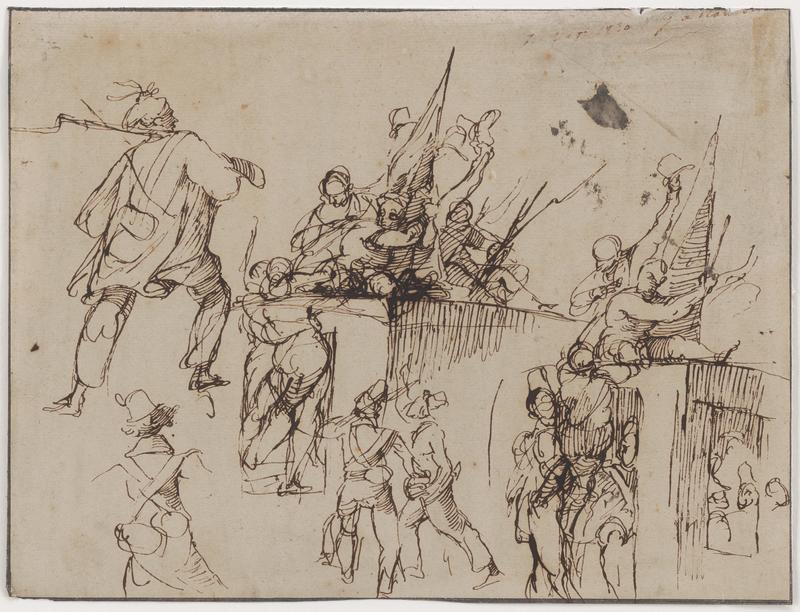
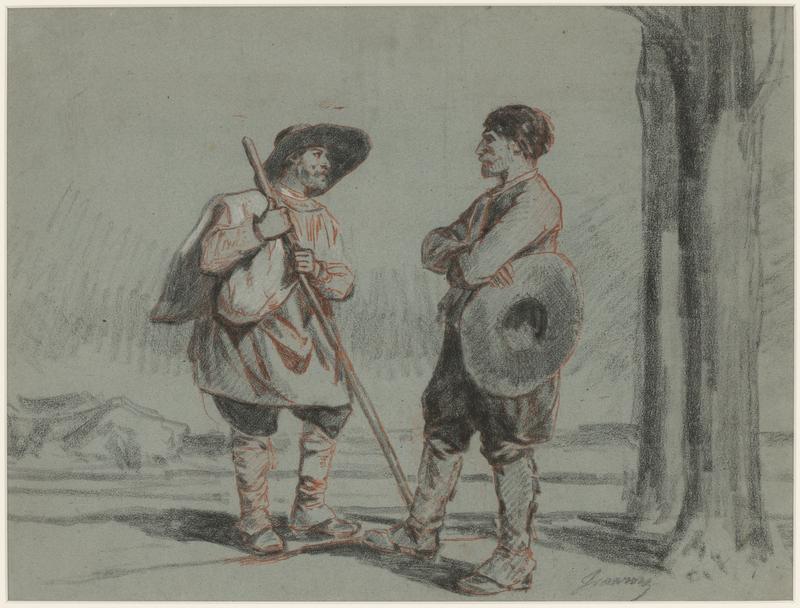
90–91. Philippe Auguste Jeanron, On the Barricades and The Meeting
| Artist | Philippe Auguste Jeanron, French, Boulogne-sur-Mer, Pas-de-Calais 1809–Comborn, Corrèze 1877 |
| Title, Date | On the Barricades, 1830 |
| Medium | Pen and ink |
| Dimensions | 7 3/4 × 10 1/4 in. (19.7 × 26 cm) |
| Inscriptions + Marks | Upper right: July 1830 Jeanron |
| Provenance | [Galerie Paul Prouté, Paris; to Weisberg]; Yvonne and Gabriel Weisberg, Minneapolis |
| Exhibition History | "The Quieter Image: 19th Century European Drawings and Watercolors," Carleton Art Gallery, Carleton College, Northfield, Minn., 1996, no. 29 |
| Credit Line | Promised gift of Gabriel P. and Yvonne M.L. Weisberg, Minneapolis |
| Artist | Philippe Auguste Jeanron, French, Boulogne-sur-Mer, Pas-de-Calais 1809–Comborn, Corrèze 1877 |
| Title, Date | The Meeting, 1830s |
| Medium | Black, red, and white chalk on blue paper |
| Dimensions | 13 7/8 × 18 3/8 in. (35.2 × 46.7 cm) |
| Inscriptions + Marks | Lower right in black chalk: Jeanron |
| Provenance | Sale, Le Blanc, Paris, December 14, 1990, no. 65. [Neal Fiertag, Paris, until before 1994; to Weisberg]; Yvonne and Gabriel Weisberg, Minneapolis (before 1994–2021; given to Mia) |
| Exhibition History | "The Quieter Image: 19th Century European Drawings and Watercolors," Carleton Art Gallery, Carleton College, Northfield, Minn., 1996, no. 28; "Expanding the Boundaries: Selected Drawings from the Yvonne and Gabriel P. Weisberg Collection," Mia (2008) and Snite Museum of Art, Notre Dame, Ind. (2010); "Reflections on Reality: Drawings and Paintings from the Weisberg Collection," Mia, 2022–23 |
| References | Petra ten-Doesschate Chu and Gabriel P. Weisberg, eds., "The Popularization of Images: Visual Culture under the July Monarchy" (Princeton, N.J.: Princeton University Press, 1994), p. 107, fig. 45; Madeleine Rousseau et al., "La vie et l’oeuvre de Philippe-Auguste Jeanron: Peintre, écrivain, directeur des Musées Nationaux, 1808–1877" (Paris: Éditions de la Réunion des Musées Nationaux, 2000), p. 235, no. 44; Lisa Dickinson Michaux with Gabriel P. Weisberg, "Expanding the Boundaries: Selected Drawings from the Yvonne and Gabriel P. Weisberg Collection" (exh. cat.), Minneapolis Institute of Arts (Minneapolis, 2008), pp. 36–37, 39, fig. 17 |
| Credit Line | Gift of Dr. Gabriel P. and Yvonne M.L. Weisberg 2021.67.1 |
Philippe Auguste Jeanron was a harbinger of the French realist movement. From his early days, he saw how decisions by those in power could affect the lives of ordinary citizens. He spent part of his childhood on an English prison hulk (decommissioned ship), where his father was locked up for having made shoes for Napoleon’s troops. Later, while studying painting in Paris, he met students who sparked his interest in republican (antiroyalist) politics. He supported the July Revolution of 1830, which toppled Charles X, but Jeanron found his successor, Louis-Philippe, a sore letdown. The revolution gave direction to his art: from 1830 until 1848, starting as a romanticist in tune with Eugène Delacroix, he moved toward a down-to-earth Realism, depicting working-class people in a matter-of-fact way. He wrote and published political tracts and gave speeches in hopes of winning over fellow artists.
The Weisberg Collection includes two Jeanron drawings, both from the 1830s. On the Barricades consists of small studies that employ conventional academic tools—active poses, pyramidal structures, flashy penmanship, operatic pitch—to emphasize the heroism and excitement of revolution. A man with a gun and bayonet over his shoulder strides with an air of confidence. A group of revolutionaries piles into and onto a coach they have apparently commandeered. Though we do not know of a painting directly related to these sketches, their academic traits are evident in Jeanron’s first Salon submission, in 1831, The Little Patriots (fig. 1), an overt tug at republican heartstrings.
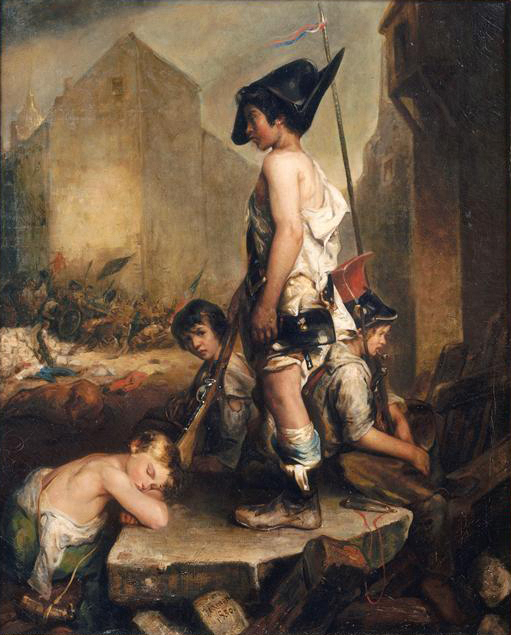
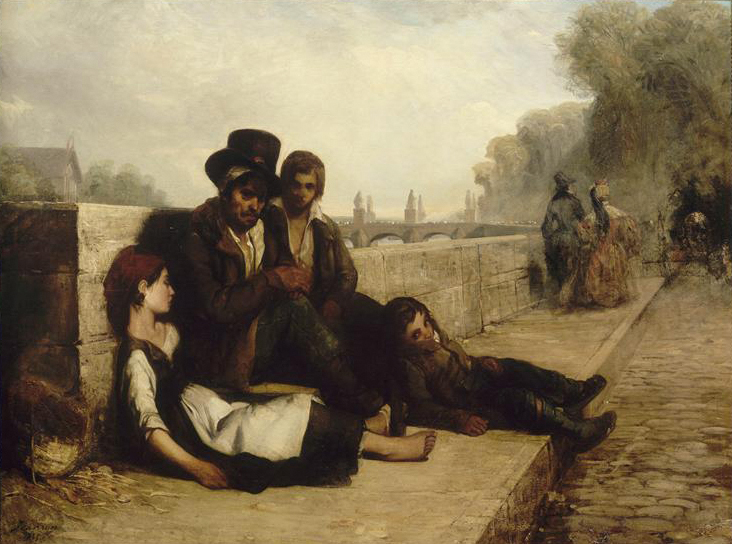
By 1833 Jeanron had replaced such romanticized heroics with a tendency to confront the viewer with real social issues, exemplified by his painting Parisian Scene (fig. 2), which shows a destitute family along the banks of the Seine. Such pictures and his outspoken politics made Paris unsafe for him. For the next few years, he lived in the south-central region of Limousin at an estate inherited by his wife. There, he turned to the kind of rural subject we see in The Meeting, where two men converse in the shadow of some trees. The man on the left wears a smock and a broad-brimmed hat typical of the Limousin region. Grasping a long staff, he looks toward his companion with concern. This second figure stands erect, arms crossed, face impassive. It could be that the man on the left has troubles, perhaps an inability to pay rent, and the man on the right cannot or will not help.
Working on blue paper, Jeanron first used red chalk to sketch the figures in outline. He then shaded them with black chalk. The sense of sunlight grazing the left-hand figure was made with white chalk. This deployment of three colors of chalk brings to mind drawings from earlier times and may reflect Jeanron’s deep academic knowledge of art history.
The Meeting is undated and has not been directly connected to another work, but its overall effect is close enough to Jeanron’s 1834 painting Peasants of Limousin (fig. 3) that we can reasonably place it in the early to middle 1830s.
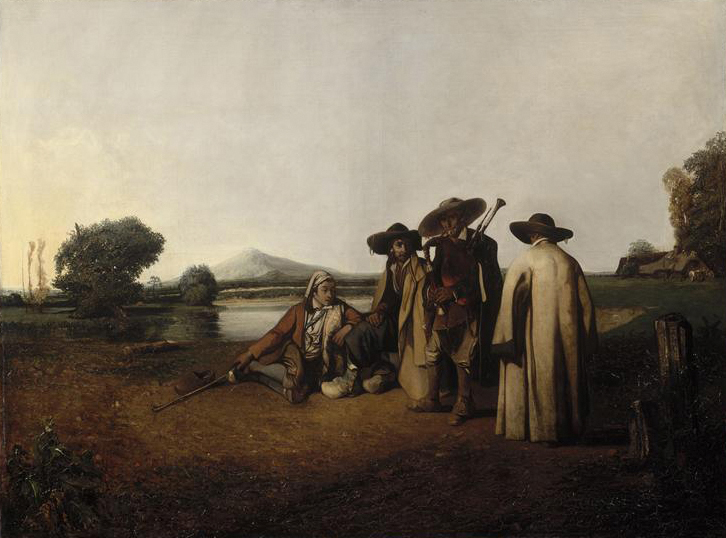
Jeanron’s drawing style evolved in ways that reflect his friendship with Honoré Daumier, arguably the greatest social critic of nineteenth-century France. In 1845 Jeanron produced a series of drawings that evoked the 1830 revolution and showed the plight of poor people, titled “The Stations of the Proletariat, Episodes from the Revolution of 1830” (“Les stations du prolétaire, épisodes de la Révolution de 1830”) (fig. 4). The word “stations” may refer to the Stations of the Cross, the story of Christ’s suffering, and thus could be a jab at the hypocrisy of those who professed piety yet let poor people suffer eviction, unemployment, sickness, and hunger.
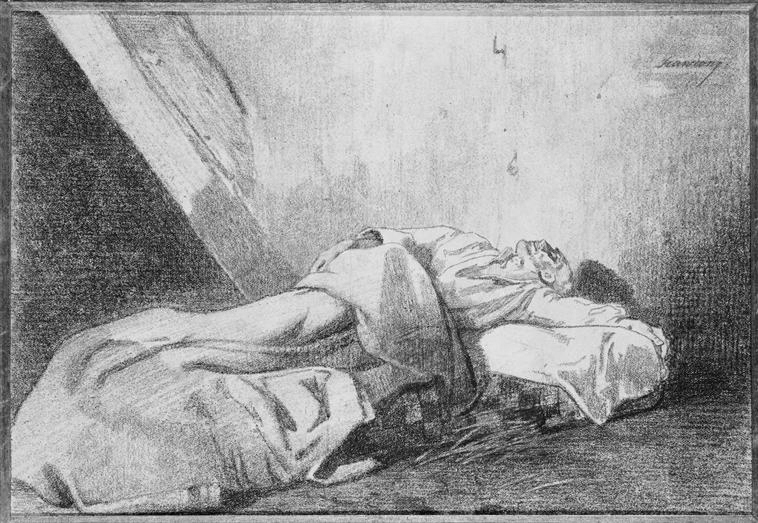
Gustave Courbet was deeply interested in Jeanron’s work and ideas. The Meeting may well have been in the back of Courbet’s mind when he painted his famous La rencontre (1854), known as Bonjour, Monsieur Courbet (fig. 5). The eminent artist showed himself as a wanderer encountering two men along a road. He carries a staff and wears a pack on his back, along with a folding easel.
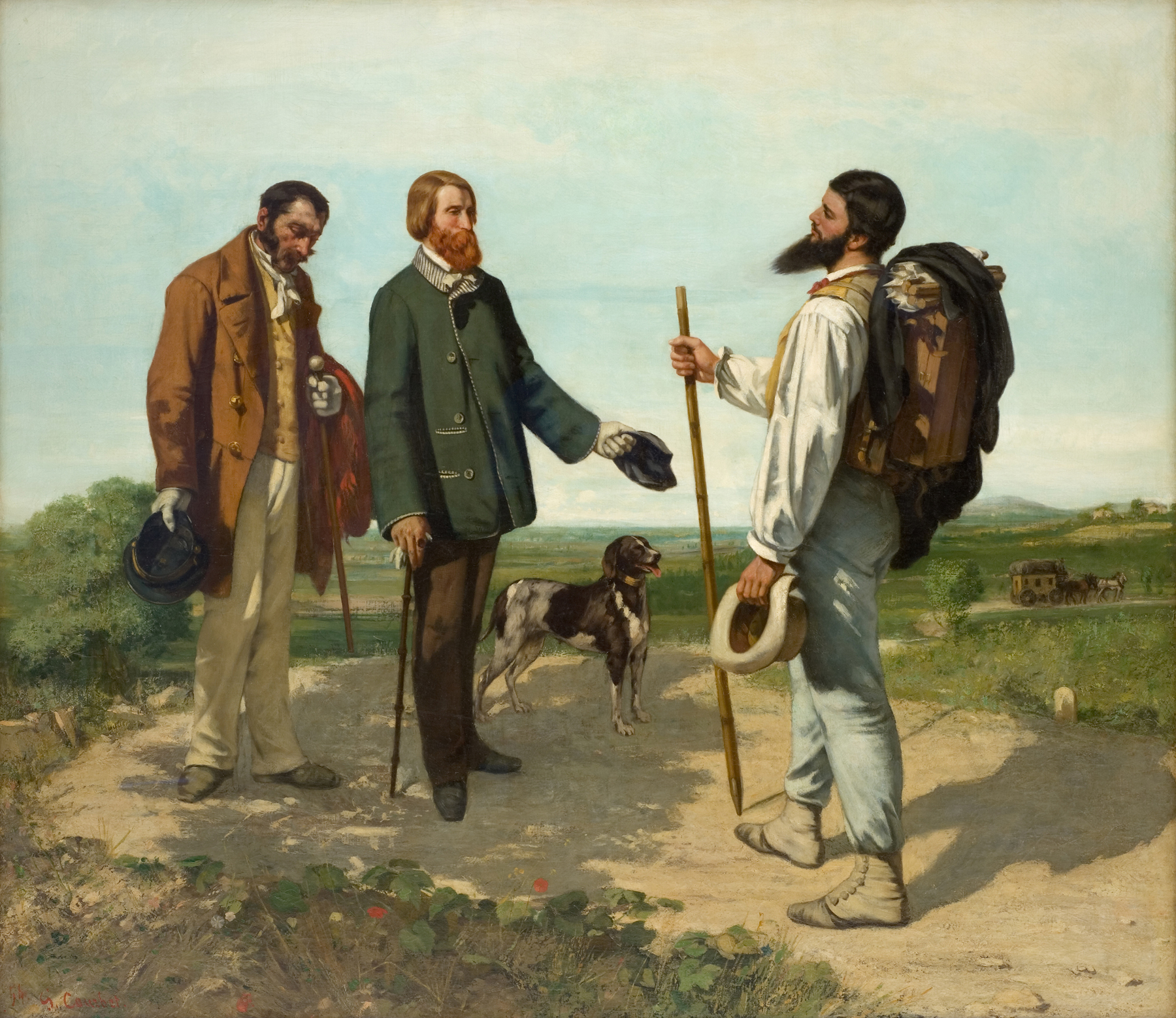
Though Jeanron was a major figure, he is not well known today. This may be due to his career choices. Because of his political views, his knowledge of history, and his practical understanding of art materials, he was named director of the National Museums, including the Louvre, in 1848. His artistic activity declined as he threw himself into museum duties. He improved security and set about improving the care of the paintings. He advanced a populist agenda, which encompassed modern art and non-aristocratic themes. He displayed the works of Jean Baptiste Chardin and the Le Nain brothers, artists who appealed to his proletarian ideas. After two years, Jeanron was out; Napoleon III was on the scene. Jeanron became director of the more provincial fine arts museum in Marseille, in southern France, where he served for twenty years. His final years, spent at the estate in Limousin, were marked by ill health and poverty.
GPW